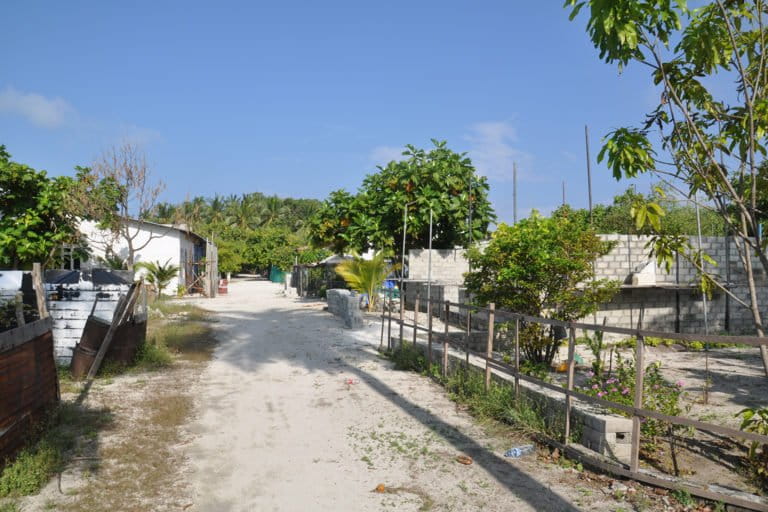- Oceanic islands host 50 percent of the world’s endangered species, but human activities can greatly disturb these isolated ecosystems.
- The number and diversity of insects and other invertebrate species decrease on islands dedicated to urban development or tourism, according to a new study in the Maldives.
- Fragmented habitats take a toll on these species on urban islands, while pesticides are the suspected culprits on tourist islands.
From above, the Lhaviyani atoll in the Maldives forms a rough oval, encircling a turquoise stretch of the Indian Ocean speckled with islands. But on the ground, populations of insects, crabs, spiders and other invertebrate species in these tropical havens have probably suffered from growing human intrusion, researchers reported recently in Royal Society Open Science.
The team took advantage of the atoll’s mosaic of land uses to examine how different human activities affect their resident invertebrates—insects and other small species without backbones. Their surveys found 48 percent fewer species on average for islands with towns and development than for untouched islands, which the scientists linked to habitat fragmentation. Islands devoted to tourism fared even worse with 66 percent fewer species on average, perhaps from heavy pesticide use to maintain landscaped grounds.

Although they attract many visitors, islands aren’t well studied—especially regarding how local creatures fare among the residents and tourists, said lead author Sebastian Steibl, an ecologist who led the study while at the University of Bayreuth in Germany. These tiny areas represent a mere 2.5 percent of Earth’s surface, yet they are home to about half of the planet’s endangered animal and plant species.
“You can make very effective conservation if you protect islands compared to other ecosystems,” Steibl told Mongabay.
But as human populations grow and tourist industries surge in the tropics, these refuges face unknown fates—particularly for their fragile ecosystems. Steibl’s research is the first to connect different atoll land usages to impacts on local diversity, filling a gap in global biodiversity loss research.
The team divided 12 islands in the atoll into three different land-use categories: urban, tourism and uninhabited, with four islands in each group. The researchers created 20 random plots of 1 square meter on each landmass. Then, they meticulously hand-counted and identified the ground-dwelling critters they found in each of the 240 squares.



Invertebrate species and their numbers were up to 70 percent lower in plots on the human-occupied islands compared to the abundance in plots on the unpopulated islands—a magnitude that shocked Steibl. It prompted the researchers to search for clues: “Can we explain this by changes in the habitat?” he asked.
To answer this question, the team used remote sensing, said co-author Jonas Franke of Remote Sensing Solutions in Munich, Germany. Satellites measured reflected sunlight from the different landscapes on the islands. The detailed images allowed Franke to map buildings and structures, plant coverage and habitat fragmentation from human uses.
Roads and buildings broke up the vegetation on urban islands. The team linked such intensive land usage to losses in the biodiversity of insects, spiders, millipedes, crabs and other crawling ground residents. However, the land usage on tourist islands—mostly scattered resorts and trails—didn’t show a close fit to these declines. Instead, this highly managed and more “artificial” landscape may be too harsh from pesticide use for many species to survive, Franke said.
“Just a one-kilometer [distance] between two islands sees a huge change in terms of vegetation types, invertebrates, insects, animals and birds,” he said.

The team’s results emphasize the threats faced by vulnerable island ecosystems, said ecologist Hillary Young of the University of California, Santa Barbara, who was not part of the study.
Young noted that the 1-square-meter ground plots might not fully capture the invertebrate populations on the islands, especially if only sampled once. It’s also difficult to “disentangle” other possible factors for this biodiversity decline, such as invasive species or resource exploitation, she said.
But the overall findings are important, Young agreed—especially the grave environmental consequences of tourism: “This adds to evidence about the negative impacts of tourism in these systems and strengthens arguments to focus on more sustainable tourism development—or we risk losing the biodiversity.”
Citation:
- Steibl, S., Franke, J., Laforsch, C. (2021) Tourism and urban development as drivers for invertebrate diversity loss on tropical islands. Royal Society Open Science, 8 (10). doi: 10.1098/rsos.210411
Brittney J. Miller (@BrittneyJMiller) is a graduate student in the Science Communication Program at the University of California, Santa Cruz. Other Mongabay stories produced by UCSC students can be found here.